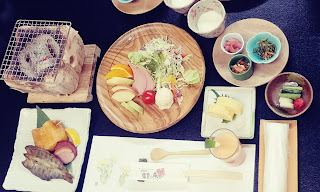Monday, March 12 and Tuesday, March 13–
Our journey to
Tsumago was a slightly convoluted one, but we got to see more alpine scenery and the Kiso Valley. We took 4 different
trains to make it to Tsumago ending up at Nagiso station where we were picked up
by our hotel’s shuttle.
Our hotel, Fukinomori, is a traditional Ryokan about 3 miles out of town on the mountainside. We are sleeping on tatami (mattresses on the floor), enjoying public bathing in the natural hot springs and eating traditional kaiseki food. Here is one evening's one-and-a-half hour, 9-course menu:
9. Dessert: Custard and greentea coated gelatin
Today after a traditional Japanese breakfast, we walked the
Nakasendo Way from Magome to Tsumago. This involved taking a shuttle from the hotel to Tsumago and then
catching a local bus to Magome.
The Nakasendo Highway was established in the 8th century to link the areas around the capital, which at that time was in Nara. This was an attempt to unite the growing empire. It became several highways during the Edo period in the 1600's, by which time the political center for the country had moved to what is now Tokyo.
The highways served as a link
between Kyoto and Tokyo and as a way to move messages, goods, personnel and spies across the empire. Villages were chosen to be post towns, responsible for the upkeep of the road and to provide food and lodging for travelers. These are steep mountainous roads with many streams, so they were most likely frequently washed out. We had to walk through a number of muddy areas on our hike.
Although the highway covers 531 kilometers, we only walked 8k between the 2 towns. We added another 3k to the Tsumago castle ruins and back. All in all a long day.
 |
| Our bed is made up while we are at dinner |
Our hotel, Fukinomori, is a traditional Ryokan about 3 miles out of town on the mountainside. We are sleeping on tatami (mattresses on the floor), enjoying public bathing in the natural hot springs and eating traditional kaiseki food. Here is one evening's one-and-a-half hour, 9-course menu:
 |
| This is just the appetizers... |
1. Zensai (Appetizers): Umeshu: Japanese Plum wine; Koi no umani: Boiled down carp fish with mixed soy sauce; Otaguri: Boiled own horse’s intestine with mixed miso and soy sauce; Wakasagi no Nabanzuke: Rolled deep fried smelt fish wrapped in Japanese radish; Soba-gome Goma Tofu: Sesame flavored buckwheat tofu; Sijimi no Tosani: Simmered freshwater clam with dried bonito
2. Yuki-masa no Sashimi: Local yuki trout
3. Kamo Nabe: Hot pot dish of sliced duck, tofu, vegetables and buckwheat noodles
4. Yurine Manju: Steamed lily bulb with mixed soy starch sauce
5. Shinsyu Salmon no Yuanyaki: Grilled Marinade shinsyu salmon
6. Wakasagi no Tempura: Deep fried smelt fish and vegetables
7. Rino-wagyu no Salad: Japanese style salad with sliced wagyu steak (cold)
8. Iwana no Kamameshi: Cooked rice with Iwana fish, pickled vegetable and miso soup
 |
| Traditional Japanese breakfast with salad and a filleted fish |
The Nakasendo Highway was established in the 8th century to link the areas around the capital, which at that time was in Nara. This was an attempt to unite the growing empire. It became several highways during the Edo period in the 1600's, by which time the political center for the country had moved to what is now Tokyo.
 |
| Start of our hike in Magome |
Although the highway covers 531 kilometers, we only walked 8k between the 2 towns. We added another 3k to the Tsumago castle ruins and back. All in all a long day.
 |
| The view from Tsumago Castle Ruins back toward Nagiso where we arrived by train yesterday. |
No comments:
Post a Comment